Greek Gods & Goddesses

Odysseus Journey Map
The Greeks celebrate their victory over Troy at the beginning of the Odyssey, forgetting that it was not their own strength that won the city, but rather the will of the gods.
In light of this neglect to give credit where it is due, Athena and Poseidon become very angry. They begged Zeus to make the Greeks suffer, and he agreed. Poseidon drowned many of their boats and made them go off-track with waves from the ocean.
However, this story is about Odysseus’ voyage in particular. He confronts not only perils set before him by fate or gods, but also common challenges that all people face such as fear, stupidity, and maliciousness of others. Here, we take a look at the Odysseus Journey Map in order. With some details about each of the locations.

- Cicones
- Lotus Eaters
- Cyclops
- Island of Aeolia
- Laestrygonians
- Circe
Teiresias and the Land of the Dead
- Circe
- Sirens
- Charybdis
- Scylla
- Calypso
- Phaeacia
The Greeks have won the Trojan War and are now journeying back to their homeland. Led by Odysseus , they could not have predicted the series of lengthy, dangerous events they would encounter along the way.
The first stop on their journey was the land of the Cicones, where they looted and pillaged to their heart’s content.
Lotus Eaters
The Lotus Eaters lived on an island where the lotus flower grew. These flowers caused anyone who ate them to forget their home and desire nothing but to stay on the island forever.
The Greeks ran into trouble when they landed on the island of the Cyclops. This one-eyed, giant creature kept the Greeks captive in his cave until they finally escaped by blinding the Cyclops.
Island of Aeolia
The next stop was the island of Aeolia, where they met the god Aeolus . He gave Odysseus a bag full of wind to help them on their journey.
Laestrygonians
The Laestrygonians were a race of giants who lived on an island and attacked the Greeks with huge boulders. Many Greek ships were destroyed and only a few men escaped.
Odysseus and his remaining men landed on the island of Circe , where they were turned into animals by the witch Circe. They were eventually turned back into humans and spent a year on the island before leaving.
Odysseus journeyed to the Land of the Dead to speak with the prophet Teiresias. The first spirit to visit Odysseus is that of the man they lost on Aeaea. This soul begs his former captain to go back and give him a burial. Next, the blind prophet Tiresias appears to him. He tells Odysseus that Poseidon is punishing the Achaeans because they blinded his son Polyphemus . Odysseus also speaks with his mother.
Upon returning to this land, Odysseus and his men partake in a burial ritual for one of their fallen comrades. Afterwards, Circe spends her last night with Odysseus.
The Sirens were creatures who sang such beautiful songs that sailors would crash their ships into the rocks just to listen. Odysseus had his men plug their ears with wax and tie him to the mast so he could hear the song without being drawn in.
Charybdis was a creature who lived under the water and would spew out a whirlpool every few days. The Greeks barely escaped her clutches.
Scylla was a creature with six heads who lived on a cliff overlooking the water. She would reach down and snatch up sailors as they passed by.
This is where they met the sun god, Helios. The Greeks angered him by eating his cattle and he punished them by causing a storm that destroyed their ship.
Odysseus was the only one who survived the storm and he washed up on the island of Calypso . She fell in love with him and held him captive for seven years.
Odysseus was finally rescued by the Phaeacians and taken back to their land. He told them the story of his journey home and they provided him with a ship to take him the rest of the way.
He finally arrived home to his wife, Penelope, and son, Telemachus. After twenty years, he was finally reunited with his family.
Link/cite this page
If you use any of the content on this page in your own work, please use the code below to cite this page as the source of the content.
Link will appear as Odysseus Journey Map: https://greekgodsandgoddesses.net - Greek Gods & Goddesses, November 1, 2022
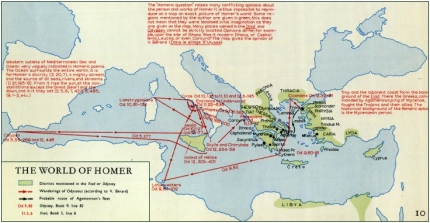

Oxford University Press's Academic Insights for the Thinking World

A map of Odysseus’s journey

The Odyssey
Odysseus--soldier, sailor, trickster, and everyman--is one of the most recognizable characters in world literature. His arduous, ten-year journey home after the Trojan War, the subject of Homer's Odyssey , is the most accessible tale to survive from ancient Greece, and its impact is still felt today across many different cultures.
- June 26 th 2014
Homer’s epic poem The Odyssey is a classic adventure filled with shipwrecks, feuds, obstacles, mythical creatures, and divine interventions. But how to visualize the thrilling voyage?
The map below traces Odysseus’s travel as recounted to the Phaeacians near the end of his wandering across the Mediterranean. Odysseus’s ten-year trek began in Asia Minor at the fallen city of Troy (the green marker) following the end of the Trojan War. His ultimate destination: his home in Ithaca (the red marker). Click the markers for information on each step of his journey. It is important to note that the 14 locations plotted on this map have been widely debated by both ancient and modern scholars.
Barry Powell, translator of a new edition of The Odyssey , asserts that the currently agreed upon location of the Island of the Sun (#11) is in fact modern-day Sicily. However, the characters in The Odyssey are in “never-never land,” and consequently, the locations plotted cannot be deemed entirely accurate.
Headline image credit: Ulysses and the Sirens by John William Waterhouse, 1891. Public domain via Wikimedia Commons .
Barry B. Powell is Halls-Bascom Professor of Classics Emeritus at the University of Wisconsin, Madison. His new free verse translation of The Odyssey was published by Oxford University Press in 2014. His translation of The Iliad was published by Oxford University Press in 2013.
- Arts & Humanities
- Classics & Archaeology
- Images & Slideshows
Our Privacy Policy sets out how Oxford University Press handles your personal information, and your rights to object to your personal information being used for marketing to you or being processed as part of our business activities.
We will only use your personal information to register you for OUPblog articles.
Or subscribe to articles in the subject area by email or RSS
Related posts:

Recent Comments
There is NO ‘republic of Macedonia! There’s only a so-called Former Yugoslav Republic of Macedonia (FYROM). Please amend your map. You of all to make such mistake?! It’s disgraceful.
Well, your work is an excellent one and enjoyed it. However, I would like to point out that your map has a huge mistake.Does not exist a state named “Republic of Macedonia”, it is FYROM. So if you want to be accepted by Greeks “Hellines”, you have to correct that name at once. FYROM did not exist at the times of Odysseus, they appeared in that territory many-many centuries later from the NE Slaves.
EDITOR’S NOTE:
The map above was created using Mapbox, which sources its geography from Open Street Map. All countries and locations named on the underlying map are modern. The former Yugoslav Republic of Macedonia is commonly referred to as ‘Republic of Macedonia’ in English for brevity (as ‘Italy’ instead of ‘Italian Republic’). This is reflected in the Open Street Map data and is not the direct work of the authors or editors.
Alice Northover OUPblog Editor
Thank you of your reply. In any case any official organization must not accept to participate to the propaganda game of Scopia.Their real old name was and is “Vardaska”. So we, Hellines, will never accept to play their game.In any case, if they want to belong to the Hellenic recent history, they have to ask their union with Hellenic state. Regarding “brevity” this is another of their games…..
Since you are interested of Greek/Hellenic history, please see/read new articles regarding recent discovery at ancient Amphipolis of Macedonia.This is the real history and not the constructed one.
Please do not seek in the Mediterranean!
Homeros was not a fanciful poet.
I say: explorations for Homeros should also be in the Netherlands, where in the ever sinking delta formerly was situated the land Phtia, twice a day inundated by the sea. Clay soils it had, with coarse clods, and the king was married to a sea goddess. Maps have recently been reconstructed.
Who wrote this
Comments are closed.
- Travels of Odysseus
Use this geotour to follow Odysseus and his crew as they encounter nymphs and narcotics, cyclopes and sirens.
English Language Arts, Geography, Human Geography
Loading ...
Learning materials.
The Odyssey is an epic , an adventure story attributed to the Greek poet Homer . Most historians think The Odyssey was composed in the 7th or 8th century B.C.E. The Odyssey tells the adventures of the Greek hero Odysseus, a veteran of the Trojan War . ( The Odyssey is a sequel to Homer's other epic, The Iliad , which tells the story of that war.) Cursed by Poseidon, god of the sea, but favored by Athena, goddess of wisdom, Odysseus sails the eastern Mediterranean for 10 years before reaching his home and family on the island of Ithaca. Use this geotour to follow Odysseus and his crew as they encounter nymphs and narcotics , cyclopes and sirens .
Geography of The Odyssey No map of The Odyssey is definitive. “You will find the scene of Odysseus’ wanderings when you find the cobbler who sewed up [his] bag of winds.” So wrote the ancient Greek geographer Eratosthenes in the 2nd century BCE. Nevertheless, countless geographers, classicists, historians, and literary critics have speculated on the landmarks of Homer’s epic. Some speculations are more exotic than others—from the Azores to the Amazon, the Caribbean to Great Britain.
Inspired by The Odyssey The travels of Odysseus have inspired writers for more than 2,000 years.
- The Roman poet Virgil wrote The Aeneid in the late 1st century BCE. The Aeneid is the story of Aeneas, as The Odyssey is the story of Odysseus. Both books tell the legend of the Trojan Horse, and both the Trojan Prince Aeneas and the Greek King Odysseus have adventures throughout the eastern Mediterranean. (Aeneas and his company of Trojans go on to settle in the western Italian region of Latium—where they became the founders of Rome.)
- Ulysses, by James Joyce, was published in 1922. Widely regarded as one of the most important English-language novels of the 20th century, Ulysses is a day in the life of two friends, Stephen Dedalus and Leopold Bloom. As Odysseus met unanticipated adventures as he roamed the Mediterranean for 10 years, so Dedalus and Bloom meet everyday adventures on their errands and strolls through Dublin, Ireland, on June 16, 1904.
- The Penelopiad , published in 2005, is Margaret Atwood’s “parallel novel” to The Odyssey . The Penelopiad tells the story of Odysseus’ wife, Penelope, from her own point of view. She recounts her childhood, her marriage, and how she governed the kingdom alone for 20 years. Penelope, narrating from the underworld of the 21st century, wonders why Odysseus’ stories have survived for so long, when Odysseus himself admits to being an accomplished liar.
The Odyssey The travels of Odysseus form just one part of The Odyssey . Another part, called the Telemachy, focuses on Odysseus’ son, Telemachus, who left home in search of his long-lost father. The final section of The Odyssey is called the Nostos (“homecoming” in Greek). The Nostos addresses Odysseus’ adventures once he returns to Ithaca: meeting Telemachus, who was an infant when Odysseus left two decades earlier; slaughtering his wife’s suitors—the men who would take Odysseus’ place as king; and, finally, reuniting with Queen Penelope, who had remained a faithful wife for 20 years.
Media Credits
The audio, illustrations, photos, and videos are credited beneath the media asset, except for promotional images, which generally link to another page that contains the media credit. The Rights Holder for media is the person or group credited.
Last Updated
October 19, 2023
User Permissions
For information on user permissions, please read our Terms of Service. If you have questions about how to cite anything on our website in your project or classroom presentation, please contact your teacher. They will best know the preferred format. When you reach out to them, you will need the page title, URL, and the date you accessed the resource.
If a media asset is downloadable, a download button appears in the corner of the media viewer. If no button appears, you cannot download or save the media.
Text on this page is printable and can be used according to our Terms of Service .
Interactives
Any interactives on this page can only be played while you are visiting our website. You cannot download interactives.
Related Resources
The best free cultural &
educational media on the web
- Online Courses
- Certificates
- Degrees & Mini-Degrees
- Audio Books
Odyssey ">An Interactive Map of Odysseus’ 10-Year Journey in Homer’s Odyssey
in Literature , Maps | December 16th, 2013 14 Comments
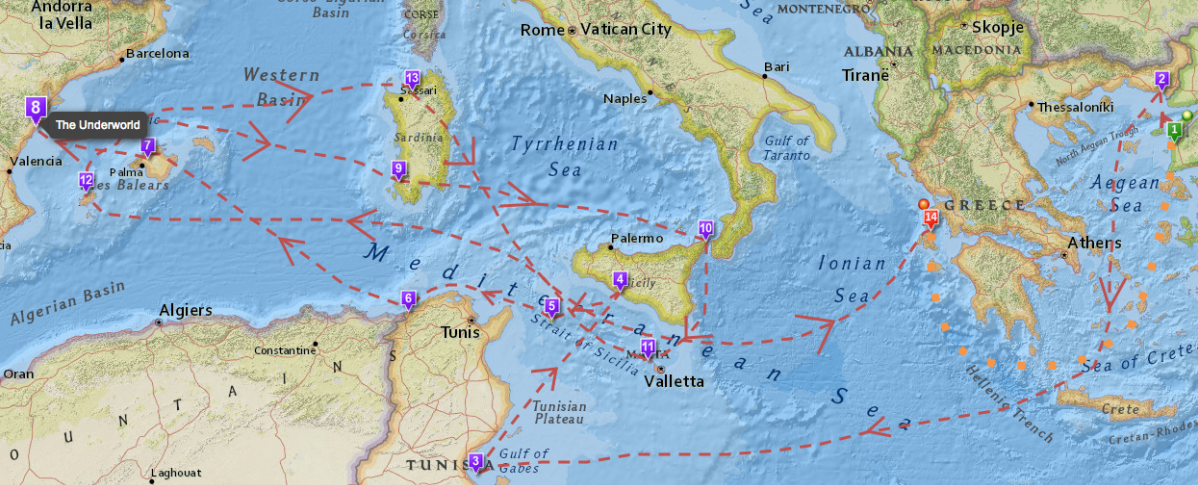
The Odyssey , one of Homer’s two great epics, narrates Odysseus’ long, strange trip home after the Trojan war . During their ten-year journey, Odysseus and his men had to overcome divine and natural forces, from battering storms and winds to difficult encounters with the Cyclops Polyphemus, the cannibalistic Laestrygones, the witch-goddess Circe and the rest. And they took a most circuitous route, bouncing all over the Mediterranean, moving first down to Crete and Tunisia. Next over to Sicily, then off toward Spain, and back to Greece again.
If you’re looking for an easy way to visualize all of the twists and turns in The Odyssey, then we’d recommend spending some time with the interactive map created by Gisèle Mounzer . “Odysseus’ Journey” breaks down Odysseus’ voyage into 14 key scenes and locates them on a modern map designed by Esri, a company that creates GIS mapping software.
Meanwhile, if you’re interested in the whole concept of ancient travel, I’d suggest revisiting one of our previous posts: Play Caesar: Travel Ancient Rome with Stanford’s Interactive Map . It tells you all about ORBIS , a geospatial network model, that lets you simulate journeys in Ancient Roman. You pick the points of origin and destination for a trip, and ORBIS will reconstruct the duration and financial cost of making the ancient journey. Pretty cool stuff.
If you would like to sign up for Open Culture’s free email newsletter, please find it here . Or follow our posts on Threads , Facebook , BlueSky or Mastodon .
If you would like to support the mission of Open Culture, consider making a donation to our site . It’s hard to rely 100% on ads, and your contributions will help us continue providing the best free cultural and educational materials to learners everywhere. You can contribute through PayPal , Patreon , and Venmo (@openculture). Thanks!
Related Content:
Hear Homer’s Iliad Read in the Original Ancient Greek
What Ancient Greek Music Sounded Like: Hear a Reconstruction That is ‘100% Accurate’
Discover the “Brazen Bull,” the Ancient Greek Torture Machine That Doubled as a Musical Instrument
Learning Ancient History for Free
by OC | Permalink | Comments (14) |
Related posts:
Comments (14), 14 comments so far.
Pretty pictures, “interactive,” but no indication of the sources of the localizations or method. A great example of the vapidity of internet technology when used aimlessly. For a theorized and researched approach to the wanderings of Odysseus, see the site “In the Wake of Odysseus” by J. Burgess
This is a good map I tried screenshoting for my project but it didn’t let me.
Works terribly on my tablet, but then, so does this site.
This map contains an important omission:nOdysseusu2019s near return to Ithaca.nn In Bookn10 of The Odyssey Odysseus and his men, carrying the leather sack in which Aeolus had confined the winds and carried by a fair wind from the west,come within sight of Ithaca. “u201cFor nine days we sailed, night and day alike, and now on the tenth our native land came in sight, and lo, we were so near that we saw men tending the beacon fires. (28 ff. Translation A.T. Murray).Then, of course, Odysseus falls asleep and his men open the sack allowing the winds to escape and blow them all the way back to the city of Aeolus. That they had come so close to home in space and end up so far from it not only in space but in time has always struck me as one of the most poignant episodes in the poem. This map includes no indication whatsoever of that part of the journey. (Peter D. Grudin)
It should be remarked that this is just one of many possible spatial interpretations of Odysseus’ trip.
Ako se oslanjamo na Homerovu Odiseju onda ova teorija ne odgovara. Primer Kiklopova pećina na Siciliji je toloiko mala da taj događaj nije mogao da se odigra.Odisej je plovio Okean Rekom tj . Jadranom čija ostrva i danas imaju stare Grčke nazive. U Grapčevoj pećini na Hvaru pronađen je isti broj ljuskih kostura koliko je Polifem pojeo Odisejevih ljudi. Toponimi vetrovi položaj zvezda i daljine se u potpunosti poklapaju sa Jadranskim morem.
I think some of these localizations here are really far-fetched.
i had to do this for my school and it isnt interactive and i cannot find Ogygia or anythig like that. please fix this so others who come to this site arent disappointed like i am
I think that the map is a great resource for teaching, and maybe that is its aim or objective. Of course, I am now interested in the reference given: ” In the wake of Odysseus” but nevertheless, is important to interact with this places and to see them in a map and to make students know where the action took place. All is perfectible, I congratulate the effort taken by the author Gisele Mounzer. The map is not only useful but beautiful.
Homer is quite clear in the number of days Odysseus travels, the wind direction and the type of craft he is using. As a seafarer one can put all this together and do a passage plan of his journeys, as I have done in my book ‘The Odysseus Code’. For example, the distance Odysseus travels between Ogygia and the land of the Phaeacians makes it impossible for Scheria to be Corfu or even for Ogygia to be within the Mediterranean. He sails from Ogygia for 17 days non-stop (i.e. 408 hours)in an easterly direction. At less than 2.5 nautical miles per hour he would not have had steerage way on such a heavy craft — work it out! Homer even tells us what type of craft it was as we have a detailed description of its construction. But this way of tackling the question is ignored by academics who insist on placing all the journeys within the Mediterranean Sea because they relate the story to the Greeks of the Bronze Age whereas Homer is incorporating the myths and legends of the more ancient and more nautically capable Phoenicians and Minoans whose skills were largely lost after the upheaval of the Thera volcano around 1500 BC.
Too many mistakes.
did not even work
did not even work boi
How does one map where a floating island (i.e. Aeolia) was?
Add a comment
Leave a reply.
Name (required)
Email (required)
XHTML: You can use these tags: <a href="" title=""> <abbr title=""> <acronym title=""> <b> <blockquote cite=""> <cite> <code> <del datetime=""> <em> <i> <q cite=""> <s> <strike> <strong>
Click here to cancel reply.
- 1,700 Free Online Courses
- 200 Online Certificate Programs
- 100+ Online Degree & Mini-Degree Programs
- 1,150 Free Movies
- 1,000 Free Audio Books
- 150+ Best Podcasts
- 800 Free eBooks
- 200 Free Textbooks
- 300 Free Language Lessons
- 150 Free Business Courses
- Free K-12 Education
- Get Our Daily Email
Free Courses
- Art & Art History
- Classics/Ancient World
- Computer Science
- Data Science
- Engineering
- Environment
- Political Science
- Writing & Journalism
- All 1500 Free Courses
- 1000+ MOOCs & Certificate Courses
Receive our Daily Email
Free updates, get our daily email.
Get the best cultural and educational resources on the web curated for you in a daily email. We never spam. Unsubscribe at any time.
FOLLOW ON SOCIAL MEDIA
Free Movies
- 1150 Free Movies Online
- Free Film Noir
- Silent Films
- Documentaries
- Martial Arts/Kung Fu
- Free Hitchcock Films
- Free Charlie Chaplin
- Free John Wayne Movies
- Free Tarkovsky Films
- Free Dziga Vertov
- Free Oscar Winners
- Free Language Lessons
- All Languages
Free eBooks
- 700 Free eBooks
- Free Philosophy eBooks
- The Harvard Classics
- Philip K. Dick Stories
- Neil Gaiman Stories
- David Foster Wallace Stories & Essays
- Hemingway Stories
- Great Gatsby & Other Fitzgerald Novels
- HP Lovecraft
- Edgar Allan Poe
- Free Alice Munro Stories
- Jennifer Egan Stories
- George Saunders Stories
- Hunter S. Thompson Essays
- Joan Didion Essays
- Gabriel Garcia Marquez Stories
- David Sedaris Stories
- Stephen King
- Golden Age Comics
- Free Books by UC Press
- Life Changing Books
Free Audio Books
- 700 Free Audio Books
- Free Audio Books: Fiction
- Free Audio Books: Poetry
- Free Audio Books: Non-Fiction
Free Textbooks
- Free Physics Textbooks
- Free Computer Science Textbooks
- Free Math Textbooks
K-12 Resources
- Free Video Lessons
- Web Resources by Subject
- Quality YouTube Channels
- Teacher Resources
- All Free Kids Resources
Free Art & Images
- All Art Images & Books
- The Rijksmuseum
- Smithsonian
- The Guggenheim
- The National Gallery
- The Whitney
- LA County Museum
- Stanford University
- British Library
- Google Art Project
- French Revolution
- Getty Images
- Guggenheim Art Books
- Met Art Books
- Getty Art Books
- New York Public Library Maps
- Museum of New Zealand
- Smarthistory
- Coloring Books
- All Bach Organ Works
- All of Bach
- 80,000 Classical Music Scores
- Free Classical Music
- Live Classical Music
- 9,000 Grateful Dead Concerts
- Alan Lomax Blues & Folk Archive
Writing Tips
- William Zinsser
- Kurt Vonnegut
- Toni Morrison
- Margaret Atwood
- David Ogilvy
- Billy Wilder
- All posts by date
Personal Finance
- Open Personal Finance
- Amazon Kindle
- Architecture
- Artificial Intelligence
- Beat & Tweets
- Comics/Cartoons
- Current Affairs
- English Language
- Entrepreneurship
- Food & Drink
- Graduation Speech
- How to Learn for Free
- Internet Archive
- Language Lessons
- Most Popular
- Neuroscience
- Photography
- Pretty Much Pop
- Productivity
- UC Berkeley
- Uncategorized
- Video - Arts & Culture
- Video - Politics/Society
- Video - Science
- Video Games
Great Lectures
- Michel Foucault
- Sun Ra at UC Berkeley
- Richard Feynman
- Joseph Campbell
- Jorge Luis Borges
- Leonard Bernstein
- Richard Dawkins
- Buckminster Fuller
- Walter Kaufmann on Existentialism
- Jacques Lacan
- Roland Barthes
- Nobel Lectures by Writers
- Bertrand Russell
- Oxford Philosophy Lectures
Receive our newsletter!
Open Culture scours the web for the best educational media. We find the free courses and audio books you need, the language lessons & educational videos you want, and plenty of enlightenment in between.
Great Recordings
- T.S. Eliot Reads Waste Land
- Sylvia Plath - Ariel
- Joyce Reads Ulysses
- Joyce - Finnegans Wake
- Patti Smith Reads Virginia Woolf
- Albert Einstein
- Charles Bukowski
- Bill Murray
- Fitzgerald Reads Shakespeare
- William Faulkner
- Flannery O'Connor
- Tolkien - The Hobbit
- Allen Ginsberg - Howl
- Dylan Thomas
- Anne Sexton
- John Cheever
- David Foster Wallace
Book Lists By
- Neil deGrasse Tyson
- Ernest Hemingway
- F. Scott Fitzgerald
- Allen Ginsberg
- Patti Smith
- Henry Miller
- Christopher Hitchens
- Joseph Brodsky
- Donald Barthelme
- David Bowie
- Samuel Beckett
- Art Garfunkel
- Marilyn Monroe
- Picks by Female Creatives
- Zadie Smith & Gary Shteyngart
- Lynda Barry
Favorite Movies
- Kurosawa's 100
- David Lynch
- Werner Herzog
- Woody Allen
- Wes Anderson
- Luis Buñuel
- Roger Ebert
- Susan Sontag
- Scorsese Foreign Films
- Philosophy Films
- February 2024
- January 2024
- December 2023
- November 2023
- October 2023
- September 2023
- August 2023
- February 2023
- January 2023
- December 2022
- November 2022
- October 2022
- September 2022
- August 2022
- February 2022
- January 2022
- December 2021
- November 2021
- October 2021
- September 2021
- August 2021
- February 2021
- January 2021
- December 2020
- November 2020
- October 2020
- September 2020
- August 2020
- February 2020
- January 2020
- December 2019
- November 2019
- October 2019
- September 2019
- August 2019
- February 2019
- January 2019
- December 2018
- November 2018
- October 2018
- September 2018
- August 2018
- February 2018
- January 2018
- December 2017
- November 2017
- October 2017
- September 2017
- August 2017
- February 2017
- January 2017
- December 2016
- November 2016
- October 2016
- September 2016
- August 2016
- February 2016
- January 2016
- December 2015
- November 2015
- October 2015
- September 2015
- August 2015
- February 2015
- January 2015
- December 2014
- November 2014
- October 2014
- September 2014
- August 2014
- February 2014
- January 2014
- December 2013
- November 2013
- October 2013
- September 2013
- August 2013
- February 2013
- January 2013
- December 2012
- November 2012
- October 2012
- September 2012
- August 2012
- February 2012
- January 2012
- December 2011
- November 2011
- October 2011
- September 2011
- August 2011
- February 2011
- January 2011
- December 2010
- November 2010
- October 2010
- September 2010
- August 2010
- February 2010
- January 2010
- December 2009
- November 2009
- October 2009
- September 2009
- August 2009
- February 2009
- January 2009
- December 2008
- November 2008
- October 2008
- September 2008
- August 2008
- February 2008
- January 2008
- December 2007
- November 2007
- October 2007
- September 2007
- August 2007
- February 2007
- January 2007
- December 2006
- November 2006
- October 2006
- September 2006
©2006-2024 Open Culture, LLC. All rights reserved.
- Advertise with Us
- Copyright Policy
- Privacy Policy
- Terms of Use
Thinking Humanity
- Home Thinking Humanity - Freedom of Speech, Human Values, Human Rights and Justice! Topics about Science and Technology, Energy and Sustainability, Consciousness and Philosophy, Truth, Awareness, Self-Improvement and the Universe. Health, Education, Documentaries, Humanism & Activism, Photography, Arts and more!
- Global News The latest interesting news from around the globe.
- Environment Our beautiful Earth provides us with an environment full of beautiful, extraordinary animals and landscapes. Let's explore nature together!
- Justice Justice is essential for the whole of humanity.
- Truth The word "truth" in Greek is translated as "αλήθεια," which means anti + oblivion.
- Documentaries Documentaries, thought-provoking movies, and films to expand your mind on many different topics.
- History A people without the knowledge of their past history, origin, and culture is like a tree without roots.
- Philosophy The word philosophy derives from the Greek words "φίλος" + "σοφία," which mean the friend of wisdom. Try to be knowledgable and teachable, never losing the willingness to improve your self.
- Photography Photographs and pictures for various topics.
- Quantum Physics A light touch on Quantum Physics and Metaphysics.
- Quotes Thought-provoking and mind-stretching quotes by various great personalities of the past and of the present, to enhance your brain.
- Spirituality Spirituality is the way to look yourself internally, find your inner powers, and help yourself achieve what you really want in your life.
- Art “Every child is an artist. The problem is how to remain an artist once he grows up.” -Pablo Picasso
- Human Intelligence Human intelligence and human ingenuity are the drivers of humanity to a brighter future!
- Self Improvement “There is nothing noble in being superior to your fellow man; true nobility is being superior to your former self.” -Ernest Hemingway
- Relationships “The meeting of two personalities is like the contact of two chemical substances: if there is any reaction, both are transformed.” -Carl Gustav Jung
- Quizzes & Tests Quizzes, tests, brain games & puzzles to boost your brain.
- Technology Technological innovations for various and essential aspects of our lives.
- Sustainability Sustainability and Environmental Awareness, the keys to thriving on our wonderful planet Earth.
- Do it Yourself (DIY) When you really want to achieve something, you might as well do it yourself!
- Coronavirus (CoVid-19) Useful information about the Coronavirus (CoVid-19), an infectious disease. The disease causes respiratory illness (like the flu) with symptoms such as a cough, fever, and in more severe cases, difficulty breathing. You can protect yourself by washing your hands frequently, avoiding touching your face, and avoiding close contact (1 meter or 3 feet) with unwell people. Coronavirus disease spreads primarily through contact with an infected person when they cough or sneeze. It also spreads when a person touches a surface or object that has the virus on it, then touches their eyes, nose, or mouth.
- Cures A light touch on some cures for various illnesses.
- Nutrition Proper nutrition, healthy foods, and a good lifestyle for long life.
- Shop Thinking Humanity Store, T-shirts, Hoodies, Mugs, Bags, Leggings, stickers, beach towels, and more!
Header$type=social_icons
- facebook|6.6M|Likes|Like
- instagram|155K|Followers|Follow
- twitter|7K|Followers|Follow
Interactive Map Of Odysseus’ 10-Year Journey

The Odyssey, one of Homer's two great epics, narrates Odysseus' long journey home after the Trojan war. During their 10-year journey, Odysseus and his men had to overcome divine and natural forces, from battering storms and winds to challenging encounters with the Cyclops Polyphemus, the cannibalistic Laestrygones, the witch-goddess Circe and the rest. They took a most circuitous route, bouncing all across the Mediterranean, moving down to Crete and Tunisia. Next over to Sicily, then off toward Spain, and then back to Greece again.
If you are looking for an easy way to visualize all the twists and turns in The Odyssey , then we'd suggest you spend some time with the interactive map created by Gisèle Mounzer . "Odysseus' Journey" breaks down Odysseus' voyage into fourteen key scenes and locates them on a modern map designed by Esri, a company which creates GIS mapping software.
Reference: Open Culture

Subscribe to our mailing list
Visit our new shop.
Our Social Networks$type=social_counter
- facebook|7.2M|Likes|Like
- instagram|360K|Followers|Follow
- pinterest|17K|Followers|Follow
- reddit|1.8K|Redditors|Join
- youtube|Subscribe
- telegram|Follow
/fa-clock-o/ WEEK TRENDING$type=list

RANDOM$type=list-tab$date=0$au=0$c=5$src=random-posts
- Consciousness
- Do it Yourself
- Documentaries
- Environment
- Human Intelligence
- Inspirations
- Inspiring Stories
- Mental Health
- Photography
- Quantum Physics
- Quizzes & Tests
- Relationships
- Self Improvement
- Spirituality
- Sustainability
/fa-fire/ MONTHLY POPULAR$type=one

- Privacy Policy/Cookies
$type=social_counter
This Interactive Map Shows Where Homer's 'Odyssey' Really Took Place
"Sing to me of the man, Muse, the man of twists and turns
driven time and again off course, once he had plundered
the hallowed heights of Troy.
Many cities of men he saw and learned their minds,
many pains he suffered, heartsick on the open sea,
fighting to save his life and bring his comrades home."
Related stories
- The Odyssey, Book 1, Lines 1-6
"The Odyssey," written by the poet Homer around 800 B.C.E. , is one of the greatest human works of all time.
It's also a dense read, which is why we highly recommend that you listen to it (as was originally intended ).
But listening to the entire epic takes a long time as well. That's why this interactive map by Gisèle Mounzer of esri is a great summary of the most epic homecoming journey ever told.
The cool thing about it is that it tracks Odysseus' mythical journey around the Mediterranean on a modern-day map.
Here are some passages where the words are brought to life by the map.
"Odysseus fought in the Trojan War for 10 years. After the fall of Troy, he left for his home in Ithaca, a journey which should have taken only a few weeks. It was to take ten years."
"After Odysseus and his men depart from Troy, they are greeted by friendly and calm waters. The crew made for Ismaros in the land of the Cicones. Odysseus and his men looted the city and robbed it of all its goods. Odysseus wisely told his men to board the ships quickly but they refused and fell asleep on the beach. The next morning, the Cicones returned with their fierce kinsmen from the mountains. Odysseus and his men fled to the ships as fast as they could but they lost many men still. On leaving Ismaros, Odysseus and his twelve ships were driven off course by fierce storms." esri
"when odysseus and his men landed on the island of the lotus-eaters, odysseus sent out a scouting party who ate lotus fruit with the natives. this caused them to fall sleep and stop caring about ever going home. odysseus went after the scouting party and dragged them back against their will to the ship and set sail.", check out the full map ».

- Main content
OUR ODYSSEUS

A comprehensive guide to Homer's Odyssey

Odysseus' journey home takes him all over! Keep track of his travels with this interactive map.
Digital Maps of the Ancient World
The Odyssey
Overview Book I Book II Book III Book IV Book V Book VI Book VII Book VIII Book IX Book X Book XI Book XII Book XIII Book XIV Book XV Book XVI Book XVII Book XVIII Book XIX Book XX Book XXI Book XXII Book XXIII Book XXIV
Embark on a literary odyssey with the Odyssey , one of the two major ancient Greek epic poems attributed to the illustrious Homer. Revered as one of the oldest surviving treasures of literature, this epic continues to weave its enchanting narrative for contemporary audiences. Divided into 24 books, mirroring its counterpart, the Iliad , it unfolds the epic journey of the Greek hero Odysseus , King of Ithaca, as he endeavors to return home after the conclusion of the Trojan War.
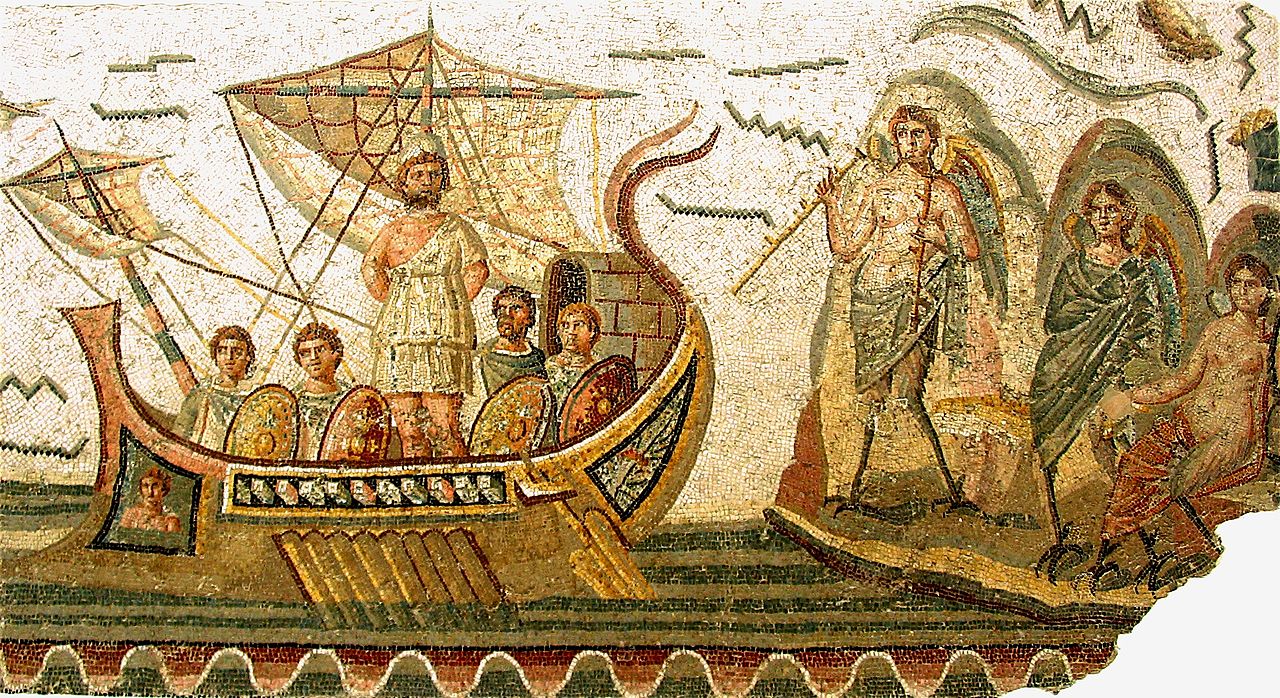
The tale transcends the war itself, spanning a remarkable two decades. For ten years, Odysseus faced the trials of battle, and for another ten, he navigated the treacherous waters of his homeward journey, encountering a myriad of dangers that tested his resilience and cunning.
Crafted in the rhythmic cadence of dactylic hexameter, the Odyssey opens in medias res, thrusting readers into the midst of the overarching story. Through a seamless interplay of flashbacks and storytelling, prior events are artfully revealed, adding depth and nuance to the hero’s epic quest.
Within the Classical period, specific books were often bestowed with individual titles:
- Books 1–4: Telemachy, focusing on the perspective of Telemachus, Odysseus’ son.
- Books 9–12: Apologoi, where Odysseus recounts his adventures to his hosts, the Phaeacians.
- Book 22: Mnesterophonia, vividly depicting the climactic slaughter of the Suitors.
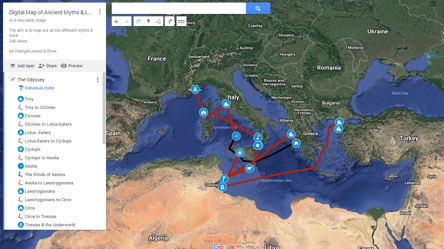
As you delve into the Odyssey , you’ll traverse not only the physical realms of the ancient Greek world but also the psychological landscapes of heroism, endurance, and the enduring bond between gods and mortals. Join us on a digital sojourn through the verses of the Odyssey , where the echoes of Odysseus’ journey resound, inviting you to relive the timeless allure of this epic tale. Welcome to a literary voyage where every page is a portal to the mythical realms of ancient Greece.
Below a synopsis of each book will be given:
Book I : The Fate of Odysseus
Book II: Assembly on Ithaca
Book III: Telemachus in Pylos
Book IV: Telemachus visits Menelaus
Book V: Odysseus sails for Phaeacia
Book VI: Odysseus and Nausicaa
Book VII: Odysseus meets Alcinous
Book VIII: The Phaeacian Banquet
Book IX: Polyphemus
Book X: Circe
Book XI: The Underworld
Book XII: The Sirens & Scylla and Charybdis
Book XIII: Odysseus arrives at Ithica
Book XIV: Odysseus seeks out Eumaeus
Book XV: Telemachus arrives home
Book XVI: A Plan is Hatched
Book XVII: A Beggar in the Palace
Book XVIII: Beggar vs. Beggar
Book XIX: Odysseus speaks with Penelope
Book XX: The Omens
Book XXI: Odysseus’ Bow
Book XXII: The Slaughter of the Suitors
Book XXIII: Odysseus and Penelope’s Reunion
Book XXIV: Peace
Share this:

Blog at WordPress.com.

- Already have a WordPress.com account? Log in now.
- Subscribe Subscribed
- Copy shortlink
- Report this content
- View post in Reader
- Manage subscriptions
- Collapse this bar
Account Options
Jump to navigation
Search form
Lapham’s quarterly, the geography of the odyssey.
Or how to map a myth.
By Elizabeth Della Zazzera
Wednesday, February 27, 2019
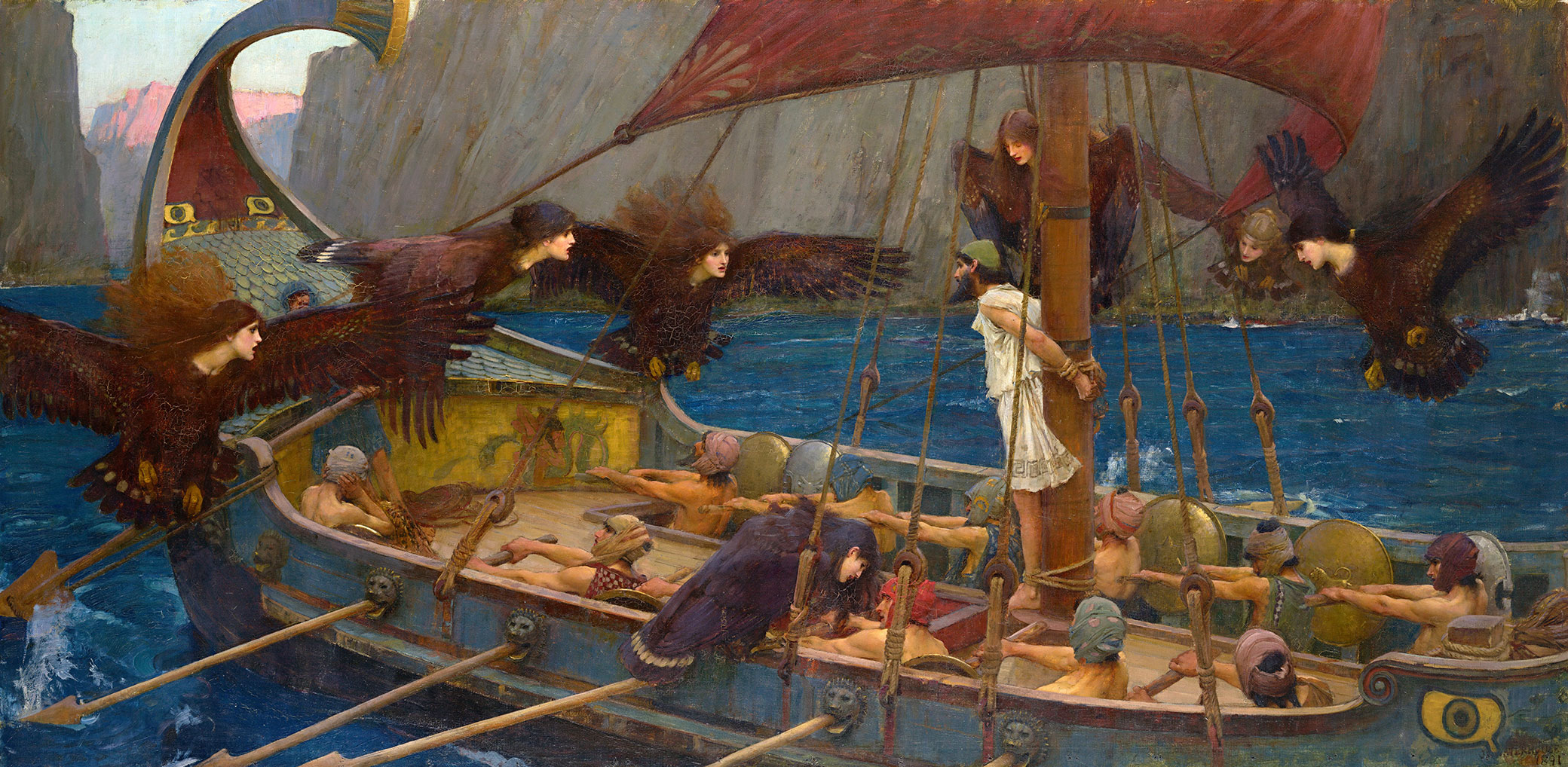
Ulysses and the Sirens , by John William Waterhouse, 1891. Google Arts & Culture , National Gallery of Victoria.
All quotations from the Odyssey are taken from Emily Wilson’s 2017 translation.
T he Odyssey , if you strip away enough allegory and myth, might serve as a travel guide for the Aegean Sea: which islands to avoid if you hate escape rooms, which cruises to skip if you always forget to pack earplugs, where to get that beef that angers the gods. But how does Odysseus’ trek across the wine-dark sea map onto an actual map of the Mediterranean?
Homer fans have been trying to figure this out—and squabbling over their findings—for as long as the Odyssey has been in the canon. And for just as long other people have been calling efforts to map the Odyssey a complete waste of time. If no one can agree on its physical geography, Odysseus’ imaginary journey is easy to retrace.
In which we take a step back to relate Odysseus’ journey
The Odyssey ostensibly tells the story of Odysseus’ ten-year journey home from war, but much of the poem concerns his absence: his wife Penelope’s clever attempts to stave off aggressive suitors and their son Telemachus’ search for his lost father.
Most of Odysseus’ wanderings are related to us after the fact. When we meet Odysseus, he has been living with the nymph Calypso for seven years on her island, Ogygia. With a little help from the gods, he escapes and travels to Scheria, where the Phaeacians welcome him and invite him to a banquet. There he tells his story.
After fighting in the Trojan War, the conflict at the heart of the Iliad , Odysseus leaves the burning city of Troy to travel back to his home, Ithaca. His fleet of twelve ships is almost immediately blown off course. He and his men end up at Ismarus, where they attack the Cicones, destroy the town, and kidnap the Cicones’ wives. The Cicones kill seventy-six of Odysseus’ men. The remainder get back on course but not for long: at Malea, they are pushed away from Cythera and caught up in storms for ten days. Next they reach the land of the Lotus-eaters, where some of Odysseus’ men succumb to the temptation of eating the addictive flowers; he must force them back to the ship. They travel to the Island of the Cyclopes, where Odysseus fights and blinds Polyphemus, one of Poseidon’s sons. From there they go to Aeolia, a floating island, where King Aeolus gifts Odysseus the bag of winds. After leaving Aeolia they nearly reach Ithaca, only to be blown off course once again when Odysseus’ men open the bag. They row for seven days until they reach Lamos, where the Laestrygonians kill and eat most of Odysseus’ men. Only Odysseus’ ship escapes and travels to Aeaea, where the goddess Circe turns his crew to swine. Odysseus, protected by Hermes, stays a year with Circe, who finally tells him to seek out the prophet Tiresias. Unfortunately, Tiresias is dead, so Odysseus must gain entry to the Underworld, which he finds in the land of the Cimmerians. He speaks to Achilles, Agammemnon, Ajax, and eventually Tiresias, who tells him how to return to Ithaca. Heeding Circe’s warning that they should avoid listening to the Sirens, Odysseus has his men, returned to human form, block their ears with wax and tie him to the mast of the ship, so that he might hear the strange sounds of the Sirens but remain unable to succumb to their magic. From there they navigate a narrow strait between rocky Scylla and the whirlpool Charybdis, arriving at the land of Helios. Odysseus tells his men not to eat the cattle they come across, but they do not listen and are punished by Zeus. Only Odysseus survives, floating to Calypso’s island, where he remains trapped for the next seven years. After the gods help him escape Calypso and he tells his story at the banquet, the Phaeacians take Odysseus back to Ithaca. And while the story does not end there, our maps of it do.
In which we debate whether mapping the Odyssey is possible or advisable
In 140 bc , about six hundred years after the Odyssey ’s composition, the Greek scholar Polybius wrote in his Histories that he could not agree with Eratosthenes’ quip that “you will find the scene of the wanderings of Odysseus when you find the cobbler who sewed up the bag of the winds.” Neither Polybius nor Eratosthenes knew of a cobbler outside the world of epic poetry capable of sewing a bag that could contain the power of the wind, but for Polybius and for many others who came after him, the Odyssey was a true story with some fantastical elements thrown in for color, not the reverse.
Polybius noted that Homer’s descriptions of fishing near Scylla corresponded directly with Sicilian fishing practices in Polybius’ time. Homer therefore must have imagined Scylla in a real location, and that location must be off the coast of Sicily.
For every Polybius working to read geographic detail in the text of an epic, there is at least one Eratosthenes denouncing the whole endeavor. In the 1980s, in a review of a book on the mapping of Homer’s Odyssey , the classicist Peter V. Jones remarked, “With books on this subject one heaves a sigh of relief to find decent spelling and the pages in the right order.”

In which many individuals try to geolocate Odysseus’ journey
Geographers of the Odyssey often built on the work of their predecessors. In his 7 bc Geographia , Strabo took his cues from Polybius, agreeing that the Odyssey was not a myth and that Homer clearly left clues placing the Odyssey ’s setting near Sicily. The famed geographer and astronomer Claudius Ptolemy included longitude and latitude for some of the places in the Odyssey in his own Geographia , an atlas, gazetteer, and treatise on cartography he wrote around 150. He included Lotophagitis (the land of the Lotus-eaters), Circaeum Promontorium (Aeaea, Circe’s realm), Sirenusae Insulae (the island of the Sirens), Scylaeum Promontorium (Scylla) as if they were any other town or geographical feature. Although Ptolemy did not draw any charts of these locations, maps created from his calculations in the fifteenth and sixteenth centuries place Lotophagitis in Africa, Circaeum Promontorium near Terracina, Sirenusae Insulae off Campagna, and Scylaeum Promontorium in the Strait of Messina. It is very difficult to transpose Ptolemy’s longitude and latitude figures into our modern conventions. His calculation of longitude begins at a different zero degree than ours, and he used an incorrect circumference of the Earth that distorted his projections and produced longitudinal distances generally one and a half times greater than they should be.
In 1597 the cartographer Abraham Ortelius became the first person to draw a map of Odysseus’ travels. Like many Homeric geographers, Ortelius identifies Scheria, home of the Phaeacians, with Corcyra (now known as Corfu) because of a passage from Thucydides ’ History of the Peloponnesian War claiming the Phaeacians were the previous inhabitants of that island. While widely accepted, this identification of Scheria with Corcyra creates a problem. Homer clearly places Calypso’s island west of Scheria, but there is no island in the Ionian Sea west of Corcyra. Ortelius, following in the footsteps of Pliny, mapped a nonexistent island off southern Italy and called it the home of Calypso. The imaginary island appeared on maps through the mid-nineteenth century, and individuals continued to search for it into the twentieth. (Perhaps it had sunk into the sea?)
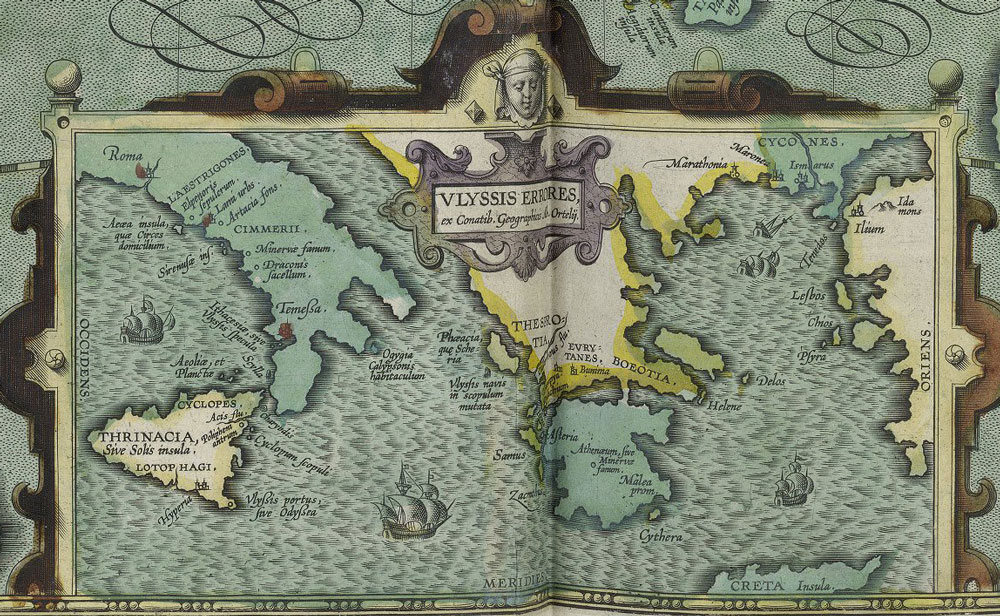
Future British prime minister William E. Gladstone saw Homer’s world as a combination of actual and imagined geography. In volume three of his Studies on Homer and the Homeric Age , he included a “Map of the World According to Homer” where a fictional landscape that includes places both real and imagined surrounds the geography of the Aegean Sea. Writing in 1858, Gladstone seems to side with Eratosthenes when he cautions, “Do not let us engage in the vain attempt to construct the geography of the Odyssey upon the basis of the actual distribution of the earth’s surface. Such a process can lead to no satisfactory result.” But Gladstone still found some value in locating Homer’s geographic and topographic references in the real world whenever possible; in doing so, he explained, we understand the extent and nature of Homer’s worldview, the physical reach of his knowledge. While Homer describes territories that are easily recognizable as Greek isles with geographic accuracy, according to Gladstone many other recognizable geographic features—the southern coast of Italy, the Caspian Sea, the Persian Gulf—are fragmentary, transposed, or (often) both. Gladstone argues that these fragmentary and transposed locations, described without precise features or travel times, were likely known to Homer only indirectly, so he could rearrange them to suit his whims. Gladstone also identified parts of Homer’s world that could never be found on a map of the Earth: the transcendent (the Underworld), as well as the merely mythical (Odysseus’ journey from the land of the Lotus-eaters to Scheria, inclusive).
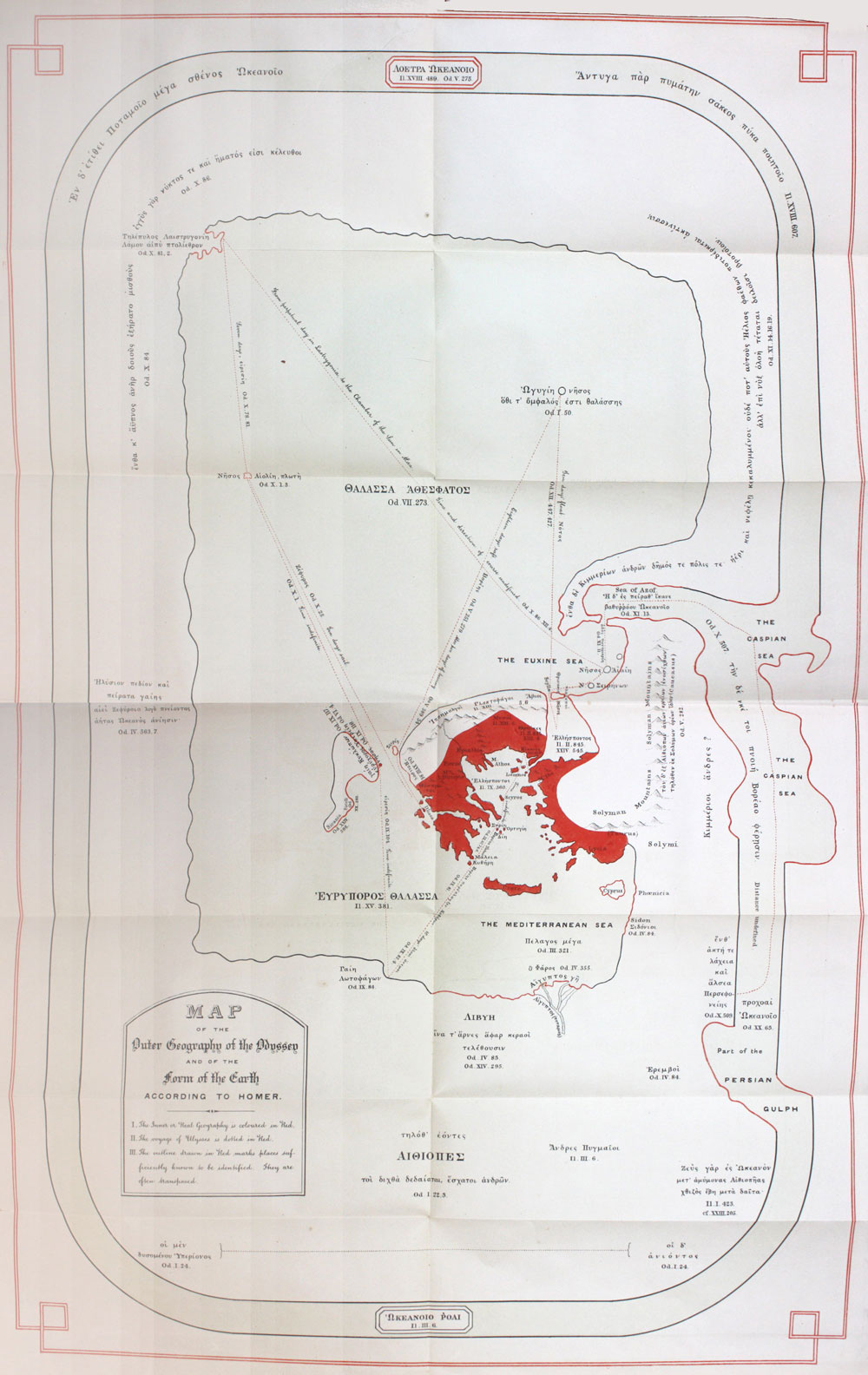
Later in the nineteenth century, the novelist and translator Samuel Butler relied primarily on topography to map Odysseus’ world, identifying specific locales from descriptions of forests, mountains, and coasts. Based on a close reading of the language and themes of the Odyssey , Butler concluded that “Homer” was a young, headstrong, unmarried woman from Sicily, specifically the region in and around Trapani on its west coast, and that area should be considered Ithaca. His cartographic reconstructions formed a significant part of his evidence for this argument; the descriptions of Ithaca were too specific to point to anything other than Trapani, he insisted, and the author’s familiarity with the region suggested that she lived there. He believed that Scheria was based on Trapani and its environs as well, specifically because of Book Thirteen, “in which passage Neptune turns the Phaeacian ship into a rock at the entrance of the Scherian harbor, I felt sure that an actual feature was being drawn from, and made a note that no place, however much it might lie between two harbors, would do for Scheria, unless at the end of one of them there was a small half sunken rock.” He searched for this sunken rock and other specific features (a nearby mountain, a town jutting out into the sea) and found them at Trapani. Based on those discoveries he insisted that the bulk of Odysseus’ journey took place in and around Sicily. This theory opens up some issues for Butler. If the Cyclopes live on Mt. Erice, the mountain visible from Trapani, and Trapani is Ithaca, then why did Odysseus not recognize how close he was to home when he fought Polyphemus? How did Odysseus travel from Scheria to Ithaca if they are both Trapani? Butler seems to have believed that much of the geographical information in the poem was simply artistic license, which allows him to ignore some details while relying on others as definitive evidence, a useful tactic in case-building that has appealed to argumentative humans throughout history.
Victor Bérard also made use of topography as evidence for his interpretation of Homeric geography. Bérard, a French diplomat and politician, took a voyage around the Mediterranean in 1912, following in Odysseus’ footsteps, taking photographs and gathering information. In 1933 his posthumously published book of photographs from the journey, Dans le sillage d’Ulysse ( In the Wake of Odysseus ) drew direct parallels between the world of the Odyssey and the world of the twentieth century. His map of Odysseus’ travels, published in his four-volume work Les navigations d’Ulysse ( The Navigations of Odysseus ) (1927–29), placed Calypso’s cave on an island near Gibraltar, his own particular innovation in the field of Odyssey geography. Gibraltar is certainly west of Corcyra. Bérard’s work spread widely in France and beyond, especially in schoolbooks; it formed the basis of the map published in the popular 1959 textbook Atlas of the Classical World , edited by A.A.M. Van Der Heyden and H.H. Scullard.
In which we ask the question, “But where is Ithaca, anyway?”
And if you find her poor, Ithaka won’t have fooled you. Wise as you will have become, so full of experience, you’ll have understood by then what these Ithakas mean. —C.F. Cavafy, “Ithaka”
The geographical descriptions in the Odyssey are never as detailed or as specific as a cartographer might like. Odysseus himself describes Ithaca’s geography and topography only briefly, saying
My fame extends to heaven, but I live in Ithaca, where shaking forest hides Mount Neriton. Close by are other islands: Dulichium, and wooded Zacynthus and Same. All the others face the dawn; my Ithaca is set apart, most distant, facing the dark. It is a rugged land, but good at raising children; to my eyes no country could be sweeter.
So Ithaca is one of a group of four islands, with smaller islands nearby, but it faces west while the others face east. (What does it mean for an island to face a direction?) It has forests and at least one mountain, and it is a good place for raising children. That isn’t much to go on.
But it is enough for some. From antiquity onward many have assumed that Homer’s Ithaca was the island Ithaca (sometimes called Ithaki or Ithaka) in the Ionian Sea. Some disagreed, pointing out discrepancies between Homer’s descriptions and the reality of the island. Others wanted to find proof to support this long-held supposition. In 1868 the famous amateur archaeologist Heinrich Schliemann conducted some minor excavations of what he claimed to be Odysseus’ palace on the isthmus Aetos, on Ithaca. In the few urns he uncovered Schliemann claimed to have found Odysseus’ and Penelope’s ashes, or at the very least those of their children. Schliemann, more famous for his later excavations of Troy at Hisarlik, said that he immediately recognized Ithaca from Homer’s descriptions. He was following growing scholarly consensus about the location of Odysseus’ Ithaca.
In 1920, Frank Brewster insisted that the passages describing Ithaca place the Homeric islands off the west coast of Greece. Brewster therefore identifies these with the Ionian Islands, and places Ithaca on the island of Ithaca, because it is, as Homer describes it, the least suitable of the four islands for chariot racing. Brewster points out that many have disagreed with this conclusion, however, with some contending that another of the islands more closely resembles Homer’s description of Ithaca and others insisting that the Ionian Islands are not Homer’s islands at all. The latter objection developed in part because one of the so-called islands, Leucas, may actually be a peninsula instead. On one side only a shallow marsh or lagoon separates Leucas from the mainland, not the deep water required for naval navigation.
What is an island, anyway? Does it need only be land surrounded by water, or does it have to be water that can be crossed only by boat or by swimming for the land to be truly “surrounded”? How deep was the water around Leucas in the time of Homer? Is it even possible to rely on topography and geographic descriptions to find locations subject to thousands of years of coastal erosion and human tampering? What is it about this story that makes people so eager to locate the exploits of gods, nymphs, and sea monsters in the real world?
In which we examine the potential value of locating sea monsters in your backyard
Unlike Middle Earth or the Hundred Acre Wood, which are arrayed in detailed maps at the beginning of the books that built them, the Homeric world—which wasn’t even constructed out of ink in the first place—does not come with its own pictorial guide. Because no one drew us a fictional landscape and told us it was the site of Odysseus’ voyage, we are left to hope, imagine, assert that his world is also ours. We can demand that Cyclopes and sirens coexist with the geographic specificity of Sicily and Corcyra. Attempts to map the Odyssey seem different from other attempts to locate the sites of famous myths and legends. Atlantis was the site of a wondrous civilization, Troy the landscape for an epic battle; finding them in the real world would mean discovering rich sources of evidence about past cultures. El Dorado’s location seems to have been coveted mainly for the lost city’s purported riches, Bimini for its rumored fountain of youth. But what do we gain by knowing where Helios kept his cows? Or which rocky, uninhabitable cave a kidnapping nymph called home?
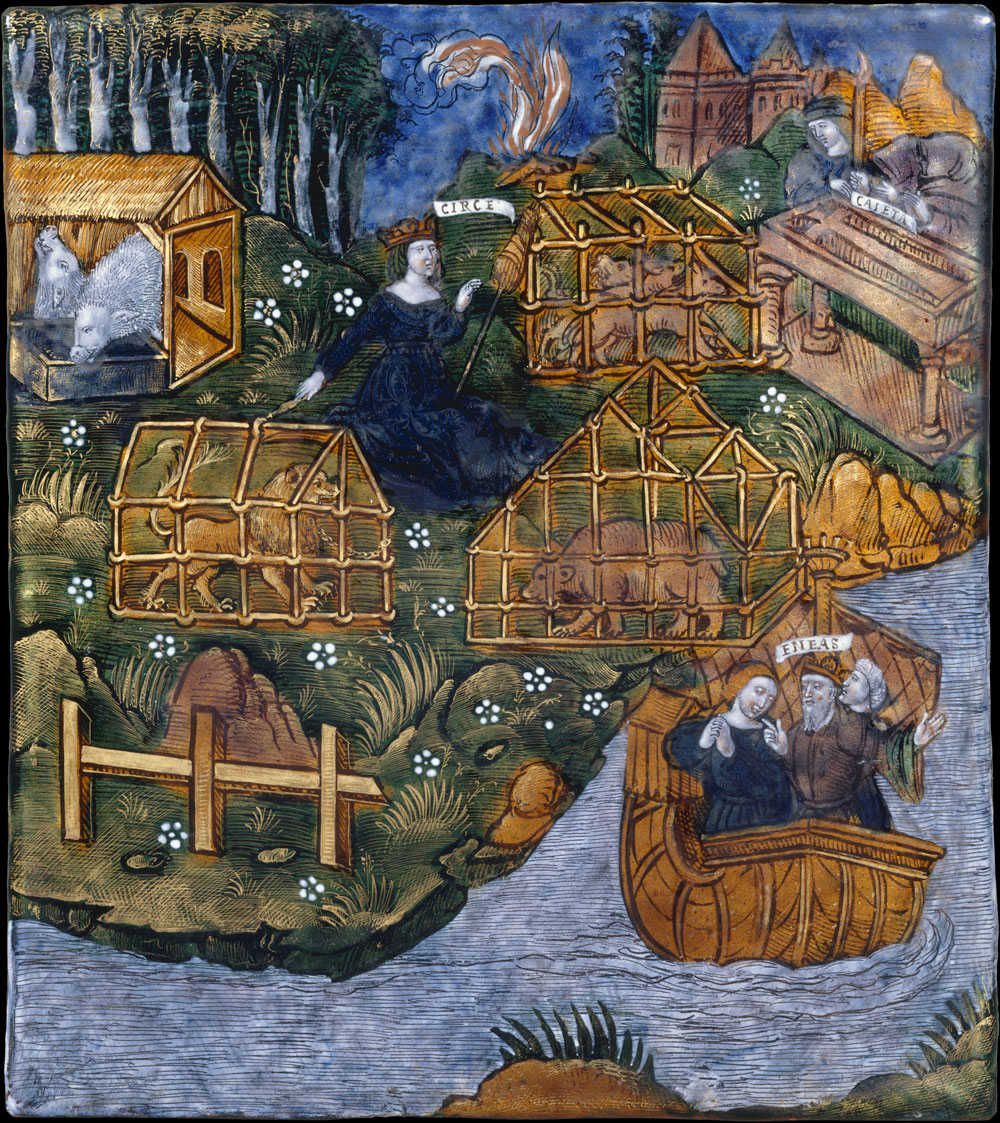
In the ancient world, imaginative reconstructions of Homeric and other mythic geographies went beyond mere exercises in intellectual curiosity. Communities wrote themselves into the Homeric world by claiming that their city’s founder had made his way home, like Odysseus, from the Trojan War. Virgil ’s Aeneid , in which Aeneas travels from Troy to Italy to sire the people who will one day be the Romans, is the most famous of these. As the scholar Irad Malkin argues in his book The Returns of Odysseus , there was political value in connecting one’s community to such lofty origins.
The desire to feel connected to the story and to bring it into the world we inhabit remains. Homer enthusiasts can even trace Odysseus’ journey on a cruise ship. In 2009, Columbia University’s alumni association held a Journey of Odysseus cruise, which took passengers from Istanbul to Athens, via a loop of the Mediterranean, stopping at several important sites from the poem, including the supposed locations of Calypso’s cave (Valetta); the Phlegraean field where Odysseus battled Polyphemus (Pompeii); Lamos, where the Laestrygonians ate Odysseus’ men (Trapani); and Scylla and Charybdis (Taormina, on the Strait of Messina). Part entertainment, part education, the tour included guided reading of the poem and lectures from experts in the field.
Created for a course on Greek and Roman mythology in 2000, the classicist Peter T. Struck ’s online interactive map of Odyssean geography is intended to give his students a general sense of Odysseus’ journey, while recognizing the uncertainty that accompanies any attempt to definitively map Homer’s locations. Struck provided his own interpretation while asking students to read the Odyssey for geographic clues and develop their own. Many of the locations Struck provides are broadly agreed upon (Troy, Ismarus), but he also locates quite a bit of the poem’s action in the western Mediterranean. Struck’s map is one of the few to chart Odysseus’ almost successful return to Ithaca, thwarted by the bag of winds, and he very clearly shows Odysseus traveling in circles.
Contributor
Elizabeth Della Zazzera
Elizabeth Della Zazzera is a historian of modern Europe and a postdoctoral research associate at the University of Connecticut Humanities Institute. She was formerly the digital producer and Mellon/ACLS Public Fellow at Lapham’s Quarterly .
- Previous The Rest Is History
- Next The Rest Is History
odysseus journey map
All Formats
Resource types, all resource types.
- Rating Count
- Price (Ascending)
- Price (Descending)
- Most Recent
Odysseus journey map
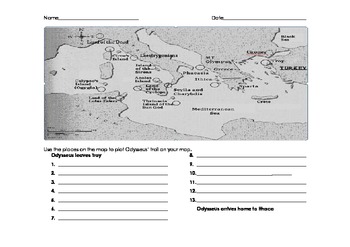
Map of Odysseus ' Journey in The Odyssey with Guided Notes and Quiz

The Odyssey - Mapping Odysseus ' Journey Bundle

- Google Apps™
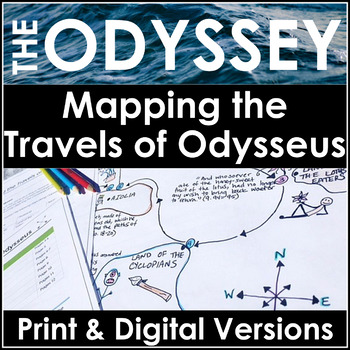
The Odyssey Map Activity and Project for High School, Use With Any Unit Plan

- Easel Activity
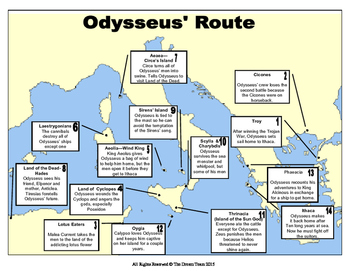
Odyssey Map - Sequencing Odysseus ' Travels for Students and Teachers

Odyssey Map Graphic Organizer Sequencing Odysseus ' Travels

The Odyssey - Final Project: Themepark Map

- Word Document File

Odyssey Map Journey Project

Odyssey Map for Student Note-taking

The Odyssey Map /Timeline Project

Odyssey Map and Journey Chart

The Odyssey Activities, a Bundle of 7 Activities w/ a Map , Bell Ringers & More!

The Epic Unit - Odyssey Map Project

- Rich Text Format

The Odyssey Unit

Worksheet: Odysseus 's Journey (EDITABLE)

- Google Docs™

Notes: VIP List from The Odyssey (Both Chronological and Categorical) (EDITABLE)
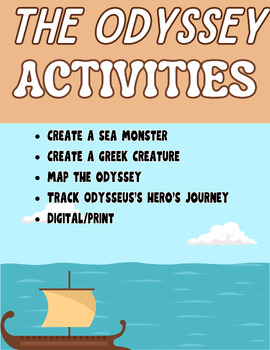
ELA The Odyssey Activities: Create Monsters, Map the Odyssey, Hero's Journey

THE ODYSSEY [BOOKS 1, 5, 9, 10, 11, & 12] [MEGA-PACK 1]

The Odyssey Reading Literature Guide and Greek Mythology Flip Book

The Odyssey Project... from a different angle

The Odyssey - Map and Icons *EDITABLE*

- Google Slides™

The Odyssey: Retelling of the Story with Activities

Introduction: The Odyssey

Map The Odyssey: Free Map for Interactive Notebook, Fun Activity

The Odyssey Book Notes and Journey Map

- We're hiring
- Help & FAQ
- Privacy policy
- Student privacy
- Terms of service
- Tell us what you think
Try changing your search query or try one of the suggestions below!
War in ukraine, free and up-to-date :), transportation to and from moscow sheremetyevo airport, what is the distance from moscow sheremetyevo airport to the centre of moscow.
The distance to the centre of Moscow (Saint Basil’s Cathedral / Red Square) is 34 kilometres from South Terminal Complex and 42 kilometres from North Terminal Complex. Thus, terminals A and B are further away from the city. Travel time between the airport and the city centre is 1 hour and 5 minutes. Unfortunately, it can be busy on the roads and you should take into account a car journey that takes longer.
From SVO Airport to Moscow City centre by Taxi
City centre
Public transport
Train aeroexpress to moscow – buy tickets.
The fastest travel option between Moscow Sheremetyevo Airport and the centre of Moscow is the train Aeroexpress. You can get stuck in a traffic jam if you travel by car, taxi or bus, that won’t happen if you take the train. The Aeroexpress commutes between Belorussky Station in the city and the railway station at the airport, located on the south side of the airport at Terminal E. An automated people mover (APM) runs between this station and terminals A and B. The Aeroexpress departs every 30 minutes, travel time is 35 minutes.
From metro station Belorusskaya at Belorussky Station, you can travel by metro to the city centre and other parts of Moscow. The journey time from metro station Belorusskaya to metro station Teatralnaya close to Red Square is only 5 minutes.
Aeroexpress tickets The prices are listed below, an Aeroexpress ticket including a ride with the metro, tram or (trolley) bus costs 560 RUB, the price for a subway ticket is 55 RUB. You can buy tickets for the Aeroexpress at the stations, but it is cheaper to do this online. Please consult website and timetable Aeroexpress for more information.

SAVING TIPS: Tickets can be bought at the airport, but online it is easier and cheaper (450 RUB one way, 900 RUB return). A group ticket can be used by four people and costs 1,100 RUB for a single journey and 1,800 RUB for a return (valid for 30 days). The price is the same online and from the ticket machine. Aeroexpress trains run without stopping, besides you can use free WiFi aboard since early 2015.
Top 5 sights in Moscow
1. Red Square – free! 2. Moscow Kremlin 3. Saint Basil’s Cathedral 4. Moscow Metro Tour of 1.5 hours 5. Communist Walking Tour of 2 hours
Bus and metro to Moscow
It is more economical to travel by bus and metro to the centre of Moscow. Needless to say, taking a direct train is easier and faster. With bus 817 and bus 948 you can get in 35 minutes to metro station Planernaya (northernmost station metro line 7). With bus 851 and bus 949 it takes 25 minutes to metro station Rechnoy Vokzal (northernmost station metro line 2). The price of a bus ticket is 57 RUB or 80 RUB.
From both stations you can take the metro to the centre of Moscow, station Kuznetskiy Most for metro line 7 (travel time: 31 minutes) and station Teatralnaya for metro line 2 (travel time: 23 minutes). Metro station Kuznetskiy Most is a short distance from the world-famous Bolshoi Theatre. The total journey time is at least one hour. If the bus ends up in a traffic jam, the journey can take a lot longer.
Tickets for the subway priced 55 RUB are available from the ticket vending machines. You can also buy a day ticket (yediniy) for public transport in Moscow for 200 RUB, it is valid for 24 hours. During the night you can travel by bus H1 between the airport and the city every half hour. Please consult buses to and from Moscow Sheremetyevo Airport and website Moscow Metro for more information.
“The metro stations with the most central location in Moscow are Okhotny Ryad (M1), Teatralnaya (M2) and Revolution Square (M3), at a short distance from Red Square, Kremlin and GUM.”
Discover and book tickets, activities and tours:
Prague: the best of mozart with opera and ballet.
Enjoy an evening in lavish style listening to a Concertino Prague Orchestra in the historical Smetana Hall. Relax as you listen to music by Mozart and marvel at the talented musicians and dancers.
Sydney: Kandinsky Exhibition at the Art Gallery of NSW
Experience a showcase of the life and work of Kandinsky, one of the most influential and best-loved European modernists at the must-see Art Gallery of New South Wales.
Yerevan: Self-Guided Tour for your Audio Device with Map
Explore the city of Yerevan on a self-guided audio tour. Dive into sights like the Sculpture Park, Republic Square, and the Cascade staircase with facinating audio commentary.
Belgrade 20th century tour
Get to know history and architecture of turbulent period in Serbian development. The most important sights and attractions from the last century.
Budapest: Private Communism Walking Tour with Museum Entry
Learn about everyday life in Budapest during the days of communism, when people drove Trabant cars and drank spirits at work. Hear about the black market and the infamous queues to buy bananas, and visit sites where revolutionary action took place.
Evening Walking Yerevan City Tour with 3 Brandy & Gata
3 types of Armenian brandy and sweet pastry Gata you need to taste in Yerevan. Welcome to our city of sun! The largest and capital city of the Republic of Armenia is Yerevan-the city older than Rome.
Tours and transport
Behind the iron curtain of tallinn - secrets of the soviets.
Get to know the Soviet history of Tallin. Visit an abandoned Soviet air defense base and find out about the former border-zone areas in Tallinn.
Riga Highlights bike tour
Explore Riga's top sights on this guided bicycle tour. Get out of the Old Town and experience beautiful parks, the Jewish Ghetto, the fascinating Moscow suburb, and see the Art Nouveau district.
Warsaw: Private 3-Hour Tour by Car with Hotel Pickup
Discover the past and present of Warsaw on a private 3-hour tour. Learn more about the history of the city and its dynamic development. See the Royal Route, Łazienki Park, and palace complex.
★★★☆☆ 2 reviews
Have you visited Moscow Sheremetyevo Airport lately? So far, 2 airport passengers have written an airport review about Moscow Sheremetyevo Airport. This airport has an average score of 3 out of 5. Provide other airport travellers with essential airport information and tell us about your airport experience.
Write a review

Theater of Conquest: Moscow (Level 4 City Event)
The new Warpath game-mode Theater of Conquest: Moscow (Level 4 City Event) is coming soon with tons of new activities, maps, and rewards!

Theater of Conquest: Moscow
- New snowing city level 4 – Moscow
- Kremlin: This strategic place is the pinnacle of Glory in Moscow, and rests in the heartland of this territory.
- Forts: Forts enable either an attack DMG or DMG Resist Buff for Alliance Members. 4 Forts provide attack buffs and another 4 forts provide resist buffs.
- Settlements: Alliances can capture these to allow its members access to more exclusive Arms EXP and Ammo on the Black Market.
- Blockhouses: These defensive fortifications activate troop durability or troop firepower buffs (Four Blockhouses for each buff).
- Arms Factories: These Factories provide Alliance Members with a 5-star unit every 2 days after 12AM UTC.
- Gold Deposits: Collection sites where commanders can mine Gold.
- New achievement demonstration – seasonal medals, and so many more!

Theater of Conquest: Moscow Participation Processes:
The event takes place in 5 stages: Preselection, Matching, Warm-up, Conquest, and Reward!
Preselection Phase
Alliances in the same server undergo an intense contest for 8 days to decide who will qualify for the Conquest: Moscow.
The top 32 Alliances will be qualified for Conquest: Moscow. The number will vary due to different active player numbers in different servers.
The qualified Alliances will be locked that player cannot join or leave the Alliance, and the Alliance cannot disband. The locking state continues until the end of Conquest: Moscow.
Matching Phase
Your Adversaries will be selected from the qualified Alliances. Groups will be formed with 8 Alliances in each to enter the Conquest.
The matching will only take place within the same server for now.
Warm-up Phase
A Warm-Up Round is held before entering the Battle of Moscow, where alliances contend for alluring buffs.
Conquest Phase
The Warm-Up Round then closes as the War in Moscow kicks off. Alliance Members representing their League in the War can then enter Moscow to fight in the War.
Every 8 Alliances will be assigned into one match for the fights, but only one will win.
While the Conquest: Moscow is in progress, participating Commanders can move into Moscow from cities around the world for free, and can spend 1 Entry Permit to move back to the original city during this phase.
Reward Phase
After the Conquest Phase ends, all Commanders who participated will earn the new officer: Ivan Andreyevich Volkov (Winter Huntsman) , and his beloved dog Shemyaka.
The higher rank you and your Alliance have, the more rewards you will get.
Alliance leaders will be able to assign extra rewards to those who perform the best during Conquest: Moscow.
Download & Play Warpath PC
Avoid lags and battery-draining when doing prolonged combats. Bonus: Play multiple accounts easily !
Download & Play Warpath on PC

IMAGES
VIDEO
COMMENTS
A map illustrating the journey home of the Achaean warrior-king Odysseus after the Trojan war.His travel from Troy to Ithaca (and his wife Penelope) took innumerable twists and turns and lasted ten years. Ever since Homer's Odyssey was written about 600 BCE (and undoubtedly long before that), people have been trying to plot the hero's trek on the Mediterranean map.
This map shows Odysseus' journey after he left Troy. While his encounters were fictional — there were no Lotus Eaters, Sirens, or Cyclopes in the ancient Mediterranean — his ports of call were real. As you can see from the names of the modern nations, the bards who sang of Odysseus sent him to very real places in the Greek world. ...
The Odyssey, one of Homer's two great epics, narrates Odysseus' long, strange trip home after the Trojan war.During their ten-year journey, Odysseus and his men had to overcome divine and natural forces, from battering storms and winds to difficult encounters with the Cyclops Polyphemus, the cannibalistic Laestrygones, the ...
Odysseus Journey Map. The Greeks celebrate their victory over Troy at the beginning of the Odyssey, forgetting that it was not their own strength that won the city, but rather the will of the gods. In light of this neglect to give credit where it is due, Athena and Poseidon become very angry. They begged Zeus to make the Greeks suffer, and he ...
Legend: 1: Troy: 8: Underworld: 2: Cicones: 9: Sirens: 3: Lotus Eaters: 10: Scylla and Charybdis: 4: Cyclopes: 11: Helios: 5: King Aiolos: 12: Calypso: 6 ...
Map of Odysseus' Journey: Odysseus' journey does not map with certainty onto any known geography. Homer doesn't specify exact locations. This has not stopped Homer's readers, ancient as well as modern, from attempting to reconstruct his travels by real world landmarks in the Mediterranean -- and it won't stop us!
Odysseus's ten-year trek began in Asia Minor at the fallen city of Troy (the green marker) following the end of the Trojan War. His ultimate destination: his home in Ithaca (the red marker). Click the markers for information on each step of his journey. It is important to note that the 14 locations plotted on this map have been widely debated ...
fictional narrative or story. (~750) ancient Greek epic poem featuring the adventures of the hero Odysseus (or Ulysses) in his journey throughout the Mediterranean Sea. mythological creature, half-woman and half-bird, who sings tantalizing songs to lure sailors to shipwrecks and death. to consider or guess.
This map contains an important omission:nOdysseusu2019s near return to Ithaca.nn In Bookn10 of The Odyssey Odysseus and his men, carrying the leather sack in which Aeolus had confined the winds and carried by a fair wind from the west,come within sight of Ithaca. "u201cFor nine days we sailed, night and day alike, and now on the tenth our native ...
Interactive Map Of Odysseus' 10-Year Journey. Katerina P. Thursday, July 4, 2019. The Odyssey, one of Homer's two great epics, narrates Odysseus' long journey home after the Trojan war. During their 10-year journey, Odysseus and his men had to overcome divine and natural forces, from battering storms and winds to challenging encounters with ...
That's why this interactive map by Gisèle Mounzer of esri is a great summary of the most epic homecoming journey ever told. The cool thing about it is that it tracks Odysseus' mythical journey ...
A comprehensive guide to Homer's Odyssey. Odysseus' journey home takes him all over! Keep track of his travels with this interactive map. Launch Interactive Map.
Divided into 24 books, mirroring its counterpart, the Iliad, it unfolds the epic journey of the Greek hero Odysseus, King of Ithaca, as he endeavors to return home after the conclusion of the Trojan War. A Roman mosaic depicting Odysseus and the Sirens. Carthage, 2nd c. AD, now in the Bardo Museum, Tunisia. The tale transcends the war itself ...
The next stop of the journey was on the island of the wind god Aeolus who welcomed them warmly and hosted them for a month. When they departed again, Aeolus gave Odysseus a leather bag full of wind that would lead them home safely. After that, they travelled fast and easily and soon they could already see the shores of Ithaca on the horizon. . However, the men were curious about what was in ...
Explore an animated map of Odysseus's adventure as displayed in the Odyssey!I upload videos based on different educational subjects for students and educator...
Key to Map of Possible Route of Odysseus Graphic: Tim Severin, The Ulysses Voyage: sea search for the Odyssey (London 1987). Text: adapted from Erich Lessing, The Voyages of Ulysses (Vienna 1965) and other sources. 1. Troy: After 10 years of siege, the Greek forces capture and destroy the city; then they sail for home with their spoils.
A transcription of the places he went to during his epic voyage. Taken in all probability, rather than certainty.
In the 1980s, in a review of a book on the mapping of Homer's Odyssey, the classicist Peter V. Jones remarked, "With books on this subject one heaves a sigh of relief to find decent spelling and the pages in the right order." In which many individuals try to geolocate Odysseus' journey
Students complete a map activity after reading Book 13 of Homer's The Odyssey. The journey Odysseus takes begins in medias res and most of the story is told through a flashback. Students unscramble the events and create a detailed and visually appealing map.This rigorous assignment requires reconstructing 17 destinations while students include textual evidence, symbols, interventions by the ...
Find local businesses, view maps and get driving directions in Google Maps.
With bus 817 and bus 948 you can get in 35 minutes to metro station Planernaya (northernmost station metro line 7). With bus 851 and bus 949 it takes 25 minutes to metro station Rechnoy Vokzal (northernmost station metro line 2). The price of a bus ticket is 57 RUB or 80 RUB. From both stations you can take the metro to the centre of Moscow ...
A tourist map with a journey of 7 kilometers (4 hours) through Moscow's student environments, on the banks of the Moskva River. 10. Moscow's Tverskaya Street. A tourist route description along the Tverskaya street, the main and best known vital artery street of Moscow. Written by: Irena Domingo Published on:
Theater of Conquest: Moscow. New snowing city level 4 - Moscow. New buildings: Kremlin: This strategic place is the pinnacle of Glory in Moscow, and rests in the heartland of this territory. Forts: Forts enable either an attack DMG or DMG Resist Buff for Alliance Members. 4 Forts provide attack buffs and another 4 forts provide resist buffs.